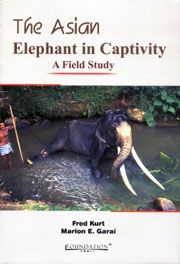Book contents
- Frontmatter
- Contents
- Preface
- Acknowledgments
- 1 Introduction
- 2 The Sri Lankan Elephant
- 3 The Captive Populations, Keeping Systems and Health
- 4 Food, Tool Use and Sleep
- 5 Musth, Reproduction, Social Integration and Stereotypy
- 6 Captive Elephants and Conservation
- 7 Base Lines and Proposals
- Appendix I
- Appendix II
- References
- Photo Gallery
- Index
1 - Introduction
Published online by Cambridge University Press: 05 February 2012
- Frontmatter
- Contents
- Preface
- Acknowledgments
- 1 Introduction
- 2 The Sri Lankan Elephant
- 3 The Captive Populations, Keeping Systems and Health
- 4 Food, Tool Use and Sleep
- 5 Musth, Reproduction, Social Integration and Stereotypy
- 6 Captive Elephants and Conservation
- 7 Base Lines and Proposals
- Appendix I
- Appendix II
- References
- Photo Gallery
- Index
Summary
According to recent estimates about 15,000 Asian elephants live in captivity. Their high number represents a quarter to a third of the total population of Elephas maximus according to the prevailing estimates of the number of surviving wild conspecifics. About 14,000 captive Asian elephants live in the countries of origin and the rest in western zoos and circuses.
Numerous reports have considered captive Asian elephants as ‘domesticated’ animals. However, most of the elephants living in captivity have been wild caught and a large number of elephants that have been bred in the range countries are offsprings of mating between captive females and wild males. Although captive elephants have existed since 3,500 years in close contact with man, they have never been the subject of sustained captive breeding programmes, nor have they been selected for particular characteristics as it was, and still is, the case with truly domesticated animals such as cattle, horses or dogs. The genetic make up of all timber and temple elephants, zoo and circus elephants has therefore not been changed and they are wild animals in captivity and should be treated accordingly.
For numerous animal welfare organisations the suffering of captive elephants has become the main subject for their campaigns, and sophisticated minds conclude that ‘elephants do not belong to captivity’, well knowing that 15,000 elephants cannot be set free and brought back to the remaining pockets of jungle, where the last wild elephants survive in habitats which have become increasingly smaller due to encroachment by a fast growing human population.
- Type
- Chapter
- Information
- The Asian Elephant in CaptivityA Field Study, pp. 1 - 3Publisher: Foundation BooksPrint publication year: 2006
- 1
- Cited by

